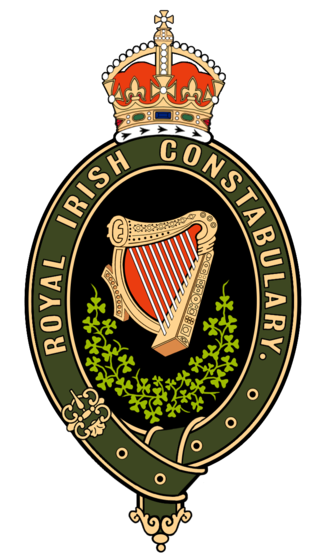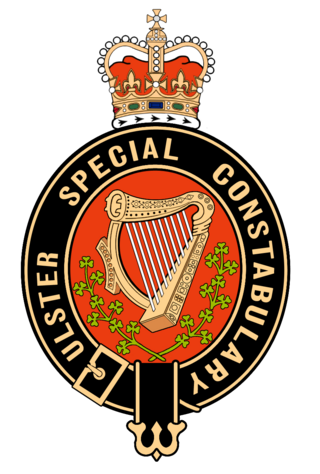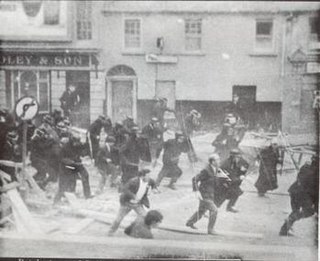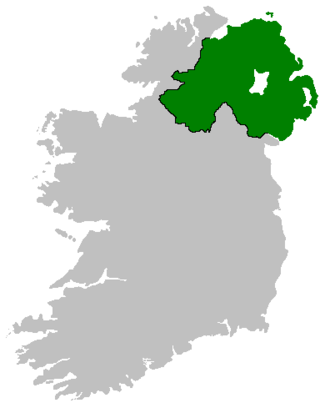Related Research Articles

The Royal Ulster Constabulary (RUC) was the police force in Northern Ireland from 1922 to 2001. It was founded on 1 June 1922 as a successor to the Royal Irish Constabulary (RIC) following the partition of Ireland. At its peak the force had around 8,500 officers, with a further 4,500 who were members of the RUC Reserve.

The Loyalist Volunteer Force (LVF) was an Ulster loyalist paramilitary group in Northern Ireland. It was formed by Billy Wright in 1996 when he and his unit split from the Ulster Volunteer Force (UVF) after breaking its ceasefire. Most of its members came from the UVF's Mid-Ulster Brigade, which Wright had commanded. In a two-year period from August 1996, the LVF waged a paramilitary campaign in opposition to Irish republicanism and the Northern Ireland peace process. During this time it killed at least 14 people in gun and bomb attacks, almost all of them Catholic civilians killed at random. The LVF called off its campaign in August 1998 and decommissioned some of its weapons, but in the early 2000s a loyalist feud led to several killings. Since then, the LVF has been largely inactive, but its members are believed to have been involved in rioting and organized crime. In 2015, the security forces stated that the LVF "exists only as a criminal group" in Mid-Ulster and Antrim.

The Royal Irish Constabulary was the police force in Ireland from 1822 until 1922, when all of the country was part of the United Kingdom. A separate civic police force, the unarmed Dublin Metropolitan Police (DMP), patrolled the capital and parts of County Wicklow, while the cities of Derry and Belfast, originally with their own police forces, later had special divisions within the RIC. For most of its history, the ethnic and religious makeup of the RIC broadly matched that of the Irish population, although Anglo-Irish Protestants were overrepresented among its senior officers.
The Red Hand Defenders (RHD) is an Ulster loyalist paramilitary group in Northern Ireland. It was formed in 1998 by loyalists who opposed the Belfast Agreement and the loyalist ceasefires. Its members were drawn mostly from the Ulster Defence Association (UDA) and Loyalist Volunteer Force (LVF). The name had first been used by Red Hand Commandos dissident Frankie Curry in 1996 and he was the leading figure in what was a somewhat unstructured organization until he was killed in 1999. It is named after the Red Hand of Ulster.

The Ulster Special Constabulary was a quasi-military reserve special constable police force in what would later become Northern Ireland. It was set up in October 1920, shortly before the partition of Ireland. The USC was an armed corps, organised partially on military lines and called out in times of emergency, such as war or insurgency. It performed this role most notably in the early 1920s during the Irish War of Independence and the 1956-1962 IRA Border Campaign.

Free Derry was a self-declared autonomous Irish nationalist area of Derry, Northern Ireland that existed between 1969 and 1972 during the Troubles. It emerged during the Northern Ireland civil rights movement, which sought to end discrimination against the Irish Catholic/nationalist minority by the Protestant/unionist government. The civil rights movement highlighted the sectarianism and police brutality of the overwhelmingly Protestant police force, the Royal Ulster Constabulary (RUC).

The Battle of the Bogside was a large three-day riot that took place from 12 to 14 August 1969 in Derry, Northern Ireland. Thousands of Catholic/Irish nationalist residents of the Bogside district, organised under the Derry Citizens' Defence Association, clashed with the Royal Ulster Constabulary (RUC) and loyalists. It sparked widespread violence elsewhere in Northern Ireland, led to the deployment of British troops, and is often seen as the beginning of the thirty-year conflict known as the Troubles.

Ulster loyalism is a strand of Ulster unionism associated with working class Ulster Protestants in Northern Ireland. Like other unionists, loyalists support the continued existence of Northern Ireland within the United Kingdom, and oppose a united Ireland independent of the UK. Unlike other strands of unionism, loyalism has been described as an ethnic nationalism of Ulster Protestants and "a variation of British nationalism". Loyalists are often said to have a conditional loyalty to the British state so long as it defends their interests. They see themselves as loyal primarily to the Protestant British monarchy rather than to British governments and institutions, while Garret FitzGerald argued they are loyal to 'Ulster' over 'the Union'. A small minority of loyalists have called for an independent Ulster Protestant state, believing they cannot rely on British governments to support them. The term 'loyalism' is usually associated with paramilitarism.
Major James Matthew Stronge was a soldier and Ulster Unionist Party MP in the Parliament of Northern Ireland, and the later Northern Ireland Assembly. He was the son and heir of Sir Norman Stronge, Bt; they were both killed by the Provisional Irish Republican Army at his family home, Tynan Abbey.

This article recounts the violence and other effects related to The Troubles in Portadown, County Armagh, Northern Ireland. Much of it has been related to the Drumcree parade dispute.

During 12–16 August 1969, there was an outbreak of political and sectarian violence throughout Northern Ireland, which is often seen as the beginning of the thirty-year conflict known as the Troubles. There had been sporadic violence throughout the year arising out of the Northern Ireland civil rights campaign, which demanded an end to discrimination against Catholics and Irish nationalists. Civil rights marches had been attacked by Protestant loyalists, and protesters often clashed with the Royal Ulster Constabulary (RUC), the overwhelmingly Protestant police force.

The Special Patrol Group (SPG) of the Royal Ulster Constabulary was a tactical reserve of 310 officers which had the role: "to provide support to divisional policing both uniform and CID, to police interface areas at times of civil unrest, and to do so in a disciplined way. The Special Patrol Group was preceded by the Reserve Force, the name was changed to Special Patrol Group in 1970 to mirror the introduction of the Metropolitan Special Patrol Group and to avoid confusion between the Reserve Force and the newly formed RUC Reserve.
Events during the year 1986 in Northern Ireland.

The Drumcree conflict or Drumcree standoff is a dispute over yearly parades in the town of Portadown, Northern Ireland. The town is mainly Protestant and hosts numerous Protestant marches each summer, but has a significant Catholic minority. The Orange Order insists that it should be allowed to march its traditional route to and from Drumcree Church on the Sunday before the Twelfth of July. However, most of this route is through the mainly Catholic/Irish nationalist part of town. The residents, who see the march as sectarian, triumphalist and supremacist, have sought to ban it from their area. The Orangemen see this as an attack on their traditions; they had marched the route since 1807, when the area was mostly farmland.
The city of Derry, Northern Ireland, was severely affected by the Troubles. The conflict is widely considered to have begun in the city, with many regarding the Battle of the Bogside in 1969 as the beginning of the Troubles. The Bloody Sunday incident of 1972 occurred in Derry, in the Bogside area.

From 6 to 11 July 1997 there were mass protests, fierce riots and gun battles in Irish nationalist districts of Northern Ireland. Irish nationalists/republicans, in some cases supported by the Provisional Irish Republican Army (IRA), attacked the Royal Ulster Constabulary (RUC) and British Army. The protests and violence were sparked by the decision to allow the Orange Order to march through a Catholic/nationalist neighbourhood of Portadown. Irish nationalists were outraged by the decision and by the RUC's aggressive treatment of those protesting against the march. There had been a bitter dispute over the march for many years.
On 11 August 1970, two Royal Ulster Constabulary (RUC) officers were killed by a booby-trap bomb planted under a car by the Provisional Irish Republican Army (IRA) near Crossmaglen, in County Armagh, Northern Ireland. They were the first RUC officers to be killed by republicans during the Troubles and the first security forces to be killed in South Armagh, an IRA stronghold for much of the conflict.
On 12 July 2001, major rioting and civil disorder broke out in Ardoyne, north Belfast, Northern Ireland. In some of the worst rioting in years, 113 police officers were injured in clashes which followed a July 12 parade. Police were attacked when trying clear the path for about 100 Orangemen returning from the parade to go through the Catholic Ardoyne area.
References
- ↑ "Our Police Cases - Critchlow and others v South Yorkshire Police". Bhatt Murphy Solicitors. Archived from the original on 29 April 2009. Retrieved 6 March 2009.
- ↑ "On this Day, 21 September – 1984: Maltby picket sparks violence". BBC News. 21 September 1984. Archived from the original on 2 October 2018. Retrieved 6 March 2009.
- ↑ Adam Gabbatt and Paul Lewis (26 November 2010). "Student protests: video shows mounted police charging London crowd | UK news | guardian.co.uk". The Guardian. UK. Archived from the original on 27 November 2010. Retrieved 4 December 2010.
- ↑ Gabbatt, Adam; Lewis, Paul; Taylor, Matthew; Williams, Rachel (26 November 2010). "Student protests: Met under fire for charging at demonstrators". The Guardian Online. London. Archived from the original on 28 November 2010. Retrieved 27 November 2010.
- ↑ Walker, Peter; Paige, Jonathan (9 December 2010). "Student protests – as they happened". The Guardian. London. Archived from the original on 19 February 2014. Retrieved 12 December 2010.
- ↑ Finlo Rohrer (4 October 2006). "Does Cable Street still matter?". BBC News. Archived from the original on 6 April 2008. Retrieved 30 July 2012.
- ↑ "Alan Dearling's "Not only but also..." memoirs of Free Festivals" (PDF). Archived (PDF) from the original on 14 March 2012. Retrieved 30 July 2012.
- ↑ Celia Stubbs (14 June 2009). "Lessons from the death of Blair Peach". The Guardian . London. Archived from the original on 10 November 2013. Retrieved 3 March 2010.
- ↑ Blair Peach inquiry ruled out Archived 2007-02-28 at the Wayback Machine , BBC News, 13 April 2009.
- ↑ Paul Lewis "Blair Peach killed by police at 1979 protest, Met report finds" Archived 2020-11-11 at the Wayback Machine , theguardian.com, 27 April 2010
- ↑ Hippies clash with police at Stonehenge Archived 2008-03-07 at the Wayback Machine (1985), BBC News archive Accessed 22 January 2008.
- ↑ Hopkins, Nick. CPS at fault over custody deaths Archived 2021-06-28 at the Wayback Machine , The Guardian, August 12, 1999.
- ↑ "Christopher Alder death: Grace Kamara exhumation date set". BBC News. 2 February 2012. Archived from the original on 16 September 2020. Retrieved 19 July 2016.
- ↑ "No charges for gun death officers". BBC News. 20 October 2005. Archived from the original on 17 February 2006. Retrieved 10 April 2006.
- ↑ Walker, Paul and Lewis, Paul. "Simon Harwood not guilty of killing Ian Tomlinson" Archived 2020-11-03 at the Wayback Machine , The Guardian, 19 July 2012.
- ↑ "PC Benjamin Monk jailed for ex-footballer's death". BBC. 29 June 2021.
- ↑ Media, P. A. (1 May 2021). "Met police officer dismissed for hitting vulnerable girl 'more than 30 times' with baton". The Guardian. Archived from the original on 4 May 2021. Retrieved 5 May 2021.
- ↑ "Met PC sacked for hitting vulnerable teenage girl with baton 34 times". BBC News. 30 April 2021. Archived from the original on 4 May 2021. Retrieved 5 May 2021.
- ↑ Berry, Franki (30 April 2021). "PC dismissed after vulnerable teenager hit with baton 'at least' 30 times". Newham Recorder. Archived from the original on 5 May 2021. Retrieved 5 May 2021.
- ↑ Israel, Simon (1 May 2021). "Met police officer dismissed for hitting vulnerable teenage girl over 30 times with a baton". Channel 4 News. Archived from the original on 3 May 2021. Retrieved 5 May 2021.
- ↑ Dodd, Vikram (15 July 2022). "Met police officer sacked after punching handcuffed black child in the face". The Guardian.
- ↑ Wiggins, Dan (3 October 2021). "Inside max security 'prison within prison' where Wayne Couzens on suicide watch". MyLondon. Retrieved 13 November 2021.
- ↑ Lynch, Robert (2006). The Northern IRA and the early years of partition, 1920–1922. Irish Academic Press. p. 122. ISBN 978-0-7165-3378-8.
The murder gang struck again after an RIC Constable, George Turner, was gunned down on the Old Lodge Road.
- ↑ Parkinson, Alan F. (2004). Belfast's Unholy War: The Troubles of the 1920s. Dublin: Four Courts Press. p. 245.
...the shooting of a Brown Square Barracks-based RIC officer, George Turner... sparked the grisly events which were to occur in north Belfast early the next morning.
- ↑ Lawlor, Pearse. The Outrages: The IRA and the Ulster Special Constabulary in the Border Campaign. Mercier Press, 2011. pp.275–280
- ↑ Lawlor, Pearse. The Outrages: The IRA and the Ulster Special Constabulary in the Border Campaign. Mercier Press, 2011. pp.302–309
- ↑ Findings on Devenny investigation Archived 29 August 2011 at the Wayback Machine , Police Ombudsman for Northern Ireland
- ↑ Index of Deaths from the Conflict in Ireland: 1981 Archived 2019-01-16 at the Wayback Machine . Conflict Archive on the Internet (CAIN).
- ↑ Chronology of the Conflict: 1981 Archived 2007-10-13 at the Wayback Machine . Conflict Archive on the Internet (CAIN).
- ↑ "RFJ: Inquest finds US citizen John Hemsworth died as result of RUC assault | RFJ-USA". 25 April 2012. Archived from the original on 25 April 2012. Retrieved 9 November 2021.
- ↑ Bryan, Fraser, Dunn. Political Rituals: Loyalist Parades in Portadown - Part 3 - Portadown and its Orange Tradition. Archived 2011-06-08 at the Wayback Machine CAIN
- 1 2 3 Mulholland, Peter. Two-Hundred Years in the Citadel Archived 2012-11-02 at the Wayback Machine . 2010.
- ↑ Bryan, Fraser, Dunn. Political Rituals: Loyalist Parades in Portadown - Part 4 - 1985 & 1986. Archived 2016-03-03 at the Wayback Machine CAIN
- ↑ "CAIN - Events in Drumcree - 1996". Cain.ulst.ac.uk. Archived from the original on 19 July 2011. Retrieved 19 April 2010.
- ↑ Tanner, Duncan (2003). Political Change and the Labour Party 1900-1918. Cambridge University Press. p. 243. ISBN 978-0-521-53053-8. Archived from the original on 18 January 2014. Retrieved 12 October 2016.